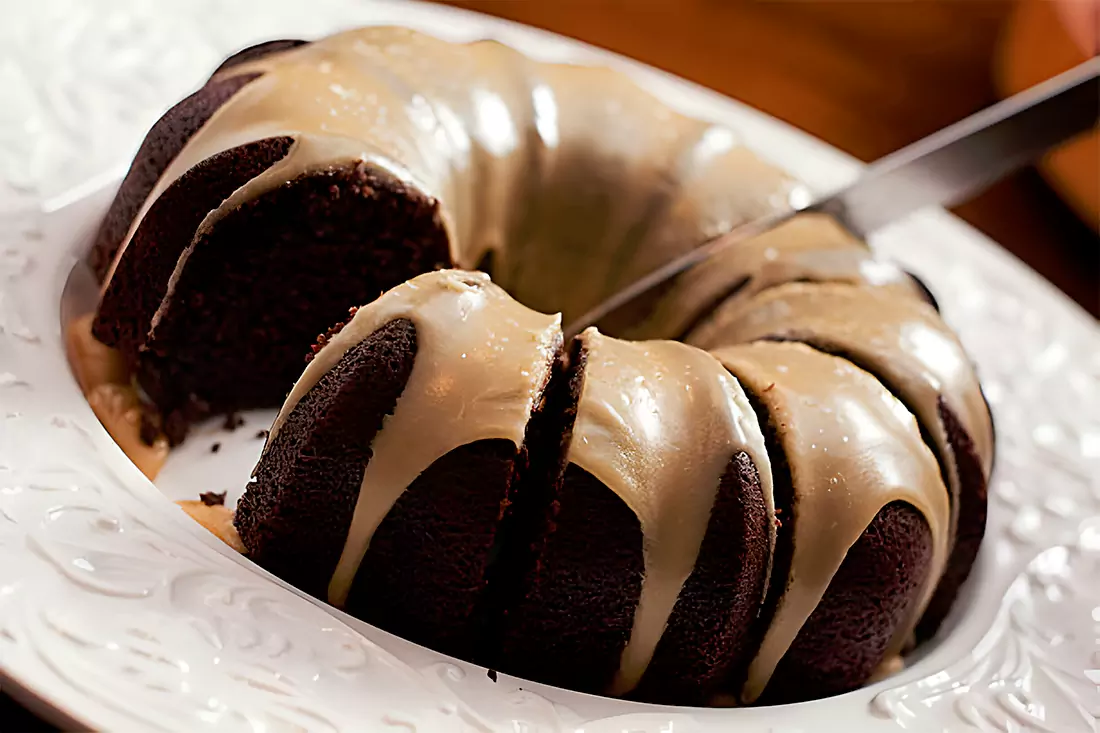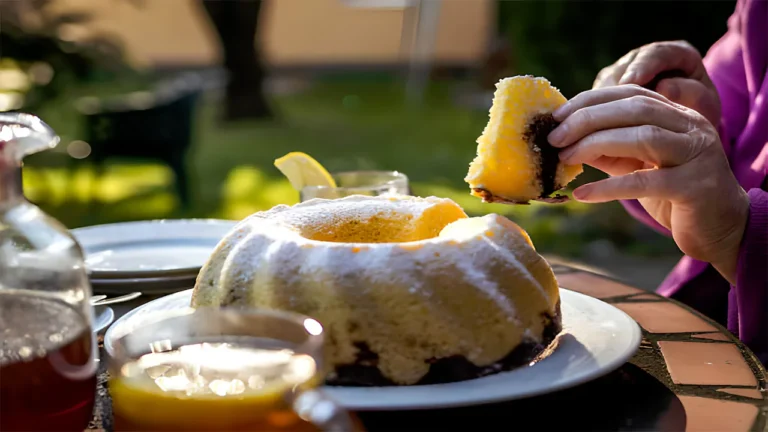Understanding Bundt Cake
The Story Behind Bundt Cakes
Bundt cakes, known for their unique doughnut shape, are more than just a treat for the eyes. Originating from Europe and gaining popularity in the United States, these cakes have a rich history that adds to their charm. The name “Bundt” comes from the German word “Bund,” meaning a gathering or bundle, symbolizing the coming together of various ingredients to create something delightful.
Why Everyone Loves Bundt Cakes
The rise in popularity of Bundt cakes can be attributed to their versatility. From the classic chocolate Bundt cake to innovative flavors like lemon, red velvet, and even pumpkin spice, there’s a Bundt cake for every palate. Moreover, they extend beyond just sweet versions. Savory Bundt cakes, incorporating ingredients like cheese and herbs, have also made their way into the culinary world, proving that when it comes to Bundt cakes, the possibilities are endless!
Ingredients and Preparation
What Goes into a Bundt Cake?
The magic of a Bundt cake lies in its simplicity. The basic ingredients include flour, sugar, eggs, and butter or oil, which are staples in most kitchens. However, it’s the proportions and the quality of these ingredients that make each Bundt cake unique. For instance, using sour cream or yogurt can add a delightful tanginess and moisture to the cake. Similarly, incorporating baking powder or baking soda helps in achieving that perfect rise, giving the Bundt cake its characteristic light and fluffy texture.
Ingredient Insights and Substitutes
Each ingredient in a Bundt cake has a specific role. Flour provides structure, sugar adds sweetness and affects texture, eggs bind the ingredients together, and fats like butter or oil contribute to the cake’s moistness. If you’re seeking healthier or dietary alternatives, use gluten-free flour blends and plant-based oils. Sweeteners like honey or maple syrup can replace sugar for a different flavor profile. These substitutions not only cater to dietary preferences but also open up a realm of creative possibilities in Bundt cake baking.For high-quality baking ingredients and tools, visit King Arthur Baking

Mastering the Mix: A Baker’s Technique
The key to a perfect Bundt cake batter is in the mixing. Start by creaming the butter and sugar until light and fluffy, which incorporates air and gives the cake its lightness. Gradually add eggs and make sure to fully incorporate each one before adding the next. Alternating between dry and wet ingredients while mixing prevents the batter from becoming too heavy or dense. Remember, overmixing can lead to a tough cake, so mix just until the ingredients are combined.
The Art of Baking a Bundt
Bundt cakes gain recognition for their even baking and beautiful shape, thanks to the Bundt pan’s design. Greasing the pan thoroughly is crucial to ensure the cake releases smoothly. A combination of melted shortening or butter with a dusting of flour works best. Bake the cake at the recommended temperature until a skewer inserted comes out clean. Cooling the cake in the pan for a short period helps in setting the structure, but don’t leave it too long, or it might stick.
Types and Flavors
Exploring Chocolate Bundt Delights
Let’s start with a classic: the chocolate Bundt cake. A true chocoholic’s dream, this cake is rich, moist, and full of deep chocolate flavor. The secret to a great chocolate Bundt cake lies in using high-quality cocoa powder and real chocolate. For an extra fudgy experience, some bakers even add coffee or espresso powder, which intensifies the chocolate flavor without overpowering it.
A World of Flavors: Beyond Chocolate
On the other side of the spectrum are the vanilla and fruit-based Bundt cakes. These cakes are lighter but no less delicious. Vanilla Bundt cakes often feature a pure, sweet flavor profile, which serves as a perfect base for a variety of glazes and toppings. Fruit-based Bundt cakes, like lemon or blueberry, are wonderfully refreshing. They often incorporate fresh or dried fruits and zests, bringing a delightful tartness and natural sweetness to the cake.
Creative Twists on Classic Bundts
For those who love to experiment, the world of specialty Bundt cakes is endlessly exciting. Think pumpkin spice Bundt cakes in the fall, a peppermint-chocolate version for the holidays, or even a savory cheese and herb Bundt cake for a brunch treat. The versatility of the Bundt cake means you can tailor flavors to seasons, occasions, or personal preferences.

Baking Perfect Bundt Cake
Bundt Baking Blunders to Avoid
Bundt cake baking is an art, but even the most experienced bakers can encounter hiccups. One common mistake is under-greasing the pan, leading to the cake sticking. Ensure every nook and cranny is well-greased. Another issue is overbaking, which can result in a dry cake. Keep an eye on the oven and perform the toothpick test a few minutes before the recipe’s suggested baking time.
Secrets to a Moist and Fluffy Cake
The secret to a moist Bundt cake lies in the ingredients and the baking process. Ingredients like sour cream, yogurt, or buttermilk add richness and moisture. Additionally, choosing the right type of flour – typically all-purpose – is crucial for the desired texture. When mixing the batter, do it just enough to combine the ingredients; overmixing can lead to a dense cake. Lastly, let the cake cool in the pan for about 10 minutes before inverting it onto a wire rack. This helps in retaining moisture and prevents the cake from falling apart.
Decorating Bundt Cakes
Dressing Up Your Bundt: Glazes and Icings
A Bundt cake’s beauty is often accentuated by its glaze or icing. A simple sugar glaze, made with powdered sugar and milk or lemon juice, drizzled over the cake can add a touch of sweetness and elegance. For chocolate Bundt cakes, a rich chocolate ganache or a chocolate glaze can be a heavenly addition. The key is to let the glaze flow naturally into the grooves of the cake, highlighting its distinctive design.
Creative Presentation Ideas for Bundt Cakes
Beyond glazes and icings, there are numerous ways to add flair to your Bundt cake. Fresh fruits, edible flowers, or a dusting of powdered sugar can create a visually stunning effect. For a festive touch, sprinkles or themed decorations can be added. If you’re serving the cake at a special event, consider how the cake’s decoration can complement the overall theme or color scheme.
Nutritional Information
Nutritional Aspects: What’s in a Slice?
When indulging in a slice of Bundt cake, it’s helpful to be aware of its caloric content. Generally, a Bundt cake can be calorie-dense due to ingredients like sugar, butter, and flour. However, the exact calorie count varies depending on the recipe and serving size. For those mindful of calorie intake, there are ways to modify recipes, such as using sugar substitutes or low-fat alternatives for dairy products.
Baking for All: Dietary Adaptations
Bundt cakes can be adapted to suit various dietary needs. Gluten-free flour blends are available for those with gluten sensitivities. For a vegan version, egg substitutes and plant-based dairy alternatives can be used. It’s also possible to reduce the sugar content or use natural sweeteners for a healthier twist. These modifications allow everyone to enjoy a slice of Bundt cake without compromising dietary preferences or restrictions.
Frequently Asked Questions

Your Bundt Cake Questions Answered
-
Can I make a Bundt cake without a Bundt pan?
- While the unique shape of a Bundt cake is due to the Bundt pan, you can use a regular round cake pan as an alternative. However, the cooking time may vary, and the iconic shape will be different.
-
How do I ensure my Bundt cake doesn’t stick to the pan?
- Thoroughly grease the pan with butter or a non-stick spray, and consider dusting it lightly with flour. This helps in creating a non-stick barrier between the cake and the pan.
-
Why did my Bundt cake come out dry?
- Dryness in cakes can often be attributed to overbaking. Make sure to check the cake a few minutes before the recipe’s suggested baking time and adjust accordingly.
Baker’s Wisdom: Expert Tips
-
Can Bundt cakes be frozen for later use?
- Absolutely! Bundt cakes freeze well. Wrap the cooled cake in plastic wrap and store it in an airtight container. You can freeze it for up to 3 months.
-
What’s the best way to add flavor to a Bundt cake?
- Incorporating ingredients like citrus zest, extracts (like almond or vanilla), spices (like cinnamon or nutmeg), or flavored liqueurs can add depth and variety to your Bundt cake.
-
How long should I cool my Bundt cake before inverting it?
- Let the cake cool in the pan for about 10 minutes. This allows the cake to set and reduces the risk of it breaking apart when inverting.
Conclusion: Summing Up the Bundt Cake Experience
Bundt cakes, with their distinctive ring shape and endless flavor possibilities, offer a delightful baking and eating experience. From understanding the basics of ingredients and preparation to exploring various types and flavors, we’ve journeyed through the art of making the perfect Bundt cake. We’ve covered essential tips for baking and decorating, as well as adapting recipes to meet different dietary needs.
Remember, the beauty of Bundt cakes lies not only in their appearance but also in their versatility. Whether you’re baking a classic chocolate Bundt cake or experimenting with new flavors and decorations, each Bundt cake you create is a chance to express your culinary creativity.
So, grab your Bundt pan, preheat your oven, and get ready to bake a masterpiece that’s as delicious to eat as it is beautiful to behold. Happy baking!
